|
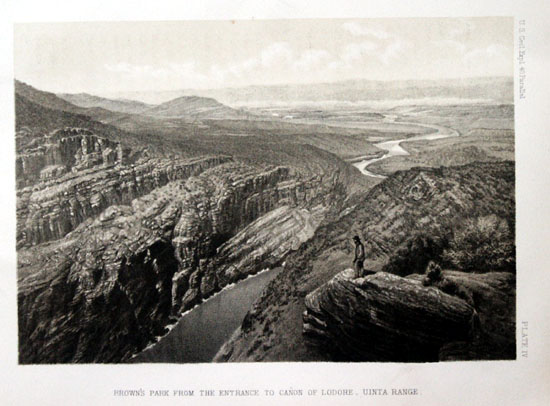
Entrance to Brown's Hole, 1877.
In the late 1890's, ranches in the Green River Valley were plagued by rustlers. To the
southeast of Green River City, across the border in Colorado, was an area cut off by mountains,
desert, and distance, known as "Brown's Hole" and now called "Brown's Park." The area served as
a refuge between robberies for the Wild Bunch, Butch Cassidy, the Sundance Kid, and others who,
perhaps, did not wish to live in close proximity to the law. As
Ann Zwinger wrote Brown's Hole was "a more or less permanent hideout for many who found total honesty a personal encumbrance."
Zwinger, Ann: Run, River, Run: A Naturalist's Journey Down One of the Great Rivers of the West (New York, 1975), p. 141.
And into the eastern end of the Hole, along the Little Snake River, a Laramie bovine king Ora Haley began moving large herds to populate
his "Two Bar Ranch" headquartered along the Little Snake River. Haley's Two Bar was not related to the Two Bar of Chugwater, its
brand was slightly different.
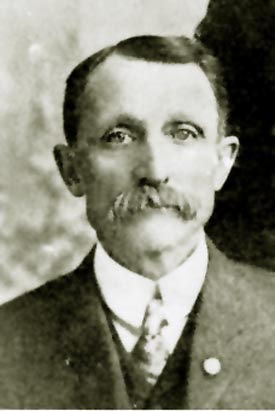 Ora Haley
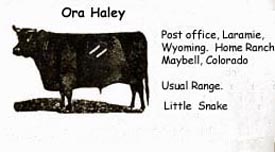
Haley was on his own at age 13 and headed west from Maine. In Colorado and later in
Wyoming he was a bullwhacker and later became a grocer in Laramie. He soon expanded eventually
owning some 50,000 acres in Wyoming and 2,500 acres in northern Colorado. In Colorado, he generally relied on open range. However, most of Brown's Hole was not
open to Open Range grazing for those who did not own land in the Hole. Initially, Haley owned land in Routt County rather than
Moffat County. He was a founder of the Snake River Stock Growers Association.
He was not necessarily a respecter
of legal niceties. A congressional investigation found that in southern Laramie County alone Haley had some
6,000 acres of government land under illegal fencing. Of course, he was not the only one. The Congressional list
was a virtual "who's Who" of the Wyoming stockgrowing industry headed up by F. E. Warren himself.
In November 1909 Haley, along with 28 others, was indicted by a federal
grand jury for illegal fencing.
In Brown's Hole a former Texas cowboy, Matt Rash established a small ranch. Rash left Texas at age of 12. He later worked for the
Middlesex Cattle Co. After it failed, he worked for the Circle K. Rash then established his own Ranch in Brown's Hole. where his initial
stock came from is unknown, but his credit was good enough that he was able to borrow sufficient funds from the First National Bank of Rock Springs to
expand his herds. Later he purchased additional lands.
Bovine Kings and small settlers do not mix. One year along the Yampa, large ranches had placed so many cattle that they ground the grass to dust.
Nevertheless large numbers of Two Bar cattle attempted to
overwhelm the valley. Later, Haley in one effort to drive out the settlers, drove 5,000 head into Brown's Hole. In retaliation,
some of Haley's cattle were driven off a cliff over the Green River to drown below. Others in the valley attempted to resolve the
problem by doing away with grass by raising sheep. Nevertheless, Haley's cattle persisted in their efforts to be absorbed into
local herds. Haley on roundups would not, contrary to usual practice, provide food for reps of other outfits or allow their
bedrolls to be carried on his hoodlum wagons.
Soon, warnings similar to those which had previously appeared along the Upper Chug began to
appear advising various individuals to leave the area.
On July 8, 1900, a tall stanger going by the name of "James Hicks," shared a meal
with Matt Rash at his cabin in Brown's Hole. Hicks earlier in the year had worked for Rash on the
spring roundup. After participating in Rash's hospitality, Hicks arose from the supper table and left Rash's cabin. Shortly thereafter
Rash emerged from his cabin and was killed with a single shot. Rash's mare was also killed. Rash had managed to crawl back into the cabin and
his bunk. There before dying, he unsuccessfully attempted to write a massage on the back of an enveloe using his own blood as ink.
Rash was engaged to be married a nearby rancher,
Ann Bassett. Bassett accused Hicks to his face of having murdered Rash. Hicks and neighbors laughed the accusation off.
The murder went unsolved.
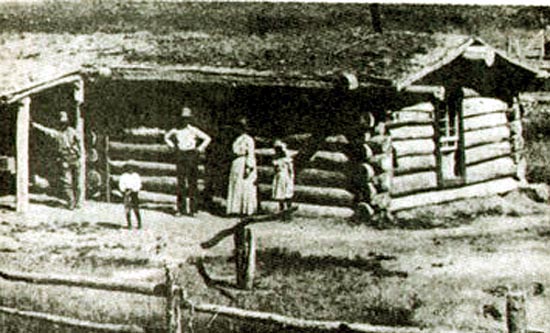
Isom Dart's Cabin
Three months later on October 4, 1900, Isom Dart (also spelled "Isham"), emerged from a cabin he was sharing
with six others. A shot rang out, and Dart fell dead. The culprit was never seen by the
occupants of the cabin. The next day, two 30-30 shells were found at the base of a
tree where it was believed that the murderer had lain in wait. Hicks was the only one in the
area to use a 30-30. Dart was popularly believed
to be a rustler named Ned Huddleston, the sole survivor of the "Tip Gault" gang. The gang, which
had rustled cattle in the Saratoga area, was wiped out in a gun battle. Huddleston had survived only because
he was out of camp that night. Dart was also suspected of rustling, having had
three indictments returned against him in Sweetwater County. No conviction, however,
ever resulted. It is believed that Dart used a method of wet branding to obscure prior brands. Wet branding involved putting
a wet gunny sack on a branding iron over the prior brand. The previous brand will then be scalded and when the scab forms, the
ridges from the prior brand will come off with the scab.
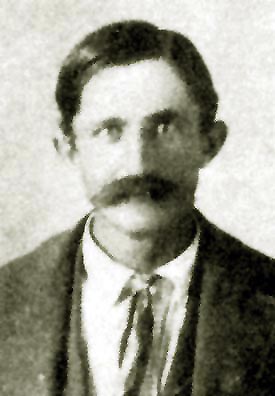
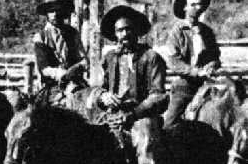
Left, Matt Rash: Right, Isom Dart in middle..
Following Dart's demise, other warnings appeared. Karen Coombs in an unpublished manuscript, Destined to be Different, The Story of Ann Bassett,
writes that the killing of Dart and Rash were not so much as to punish suspected rustlers, but instead to
scare the settlers out of the valley so that the Two Bar could take over. In December, a shot was fired at
George Banks but missed. In March another shot hit Banks' saddlehorn. Suspicion turned
to Tom Horn. Horn had been familiar with the Brown's Hole area from his days with the
Pinkerton Agency before he had moved to Wyoming and used a 30-30. It was also suspected that
Horn had been hired by Ora Haley, Charles Kelly, The Outlaw Trail: A History of Butch Cassidy and the Wild Bunch, Devin-Adair Co., 1959,
wrote that Frank Beckwith
said that his father A. C. Beckwith of the Beckwith-Quinn Ranch in Evanston, donated to a
pool to be paid to Tom Horn. Dale B. Weston in Whirlwind on the Outlaw Tail: Sheriff John T. Pope, AuthorHouse, 2011, flat out said it was
A. C. Beckwith who paid for the killings. There was only one minor difficulty with the Beckwith theory. A. C. Beckwith died in 1896. While years before at the time
of the organization of the WSGA Beckwith may have contributed money to be paid to Horn for his early
services, it is unlikely that such funds went to pay for murder. Russell Thorp, according to Kelly, p. 132, wrote in a letter dated
October 10, 1939:
Horn worked for a comparitively short time, but was not particularly successful as a livestock
detective from the association's angle. He did submit a proposition to the association, through a prominent cattleman of that
time, that he would ambush and kill those rusters that were blacklisted at $500 each. When the proposal was made, Horn was immediately dismissed from
the service of the association. Later he made private arrangements with private parties, and did kill several men, including
Willie Nichol [sic] and Isom Dart.
In 1904, Ann Bassett, yclept "the Queen of Rusters," married Hiram H. "Hi" Bernard, the manager of
Haley's Two Bar. Bernard was Bassett's senior by about twenty years. Bernard was promptly fired by Haley. Bernard then filed for homestead
adjacent to Bassett's homestead. Kelly relates that about eight years following the marriage
Bernard admitted to Ann that he had paid Horn $1,000 to dispatch Rash and Isom. The admission resulted in the breakup of the
Bassett-Bernard marriage. Horn by that time had changed his residence to the Columbia Cemetery in Boulder. Nevertheless, Horn had an alibi for at
least one of the murders, he was supposedly in Denver at the time.
The murders remained unsolved. For more on Isom Dart, see Green River.
Haley continued his war on suspected rustlers in Brown's Hole. About 1911, the Two Bar's manager offered one of his employees $500 to get the goods on
Ann Bassett. The employee refused and a cattle detective was employed. A hide on which the Two Bar brand had allegedly been cut out was found on Bassett's
ramch. Identification of the hide was made by neans of an ear mark on the left ear. She was tried for rustling. In the first trial, the jury deadlocked.
By the time of the second trial, three of the witnesses for Bassett were unaccounted for:
one had been murdered, a second left the area after being acused of being a sheep thief, and the third just disappeared.
Nevertheless, Bassett was found not guilty after Haley was exposed as having lied on his Moffat County
tax assessment forms by understating the size of his herds by half. Haley liquidated his holdings and died in Denver in 1919.
Bassett died in Leeds, Utah in 1956.
Music this page: Where the Columbines Grow, courtesy of Horse Creek Cowboy.
Next page: the murder of Willie Nickell.
|